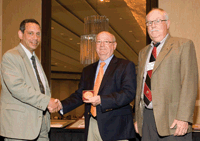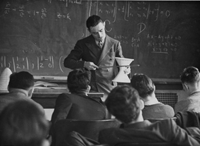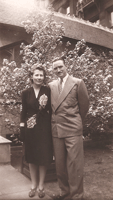A Memorable Reid Prize Lecture
September 15, 2010

As a student of W.T. Reid at the University of Oklahoma, John Burns (middle) may have missed out on some of his inscrutable adviser�s wisdom (communicated in part in the form of 54 papers slipped under his student�s door, without further comment). As the 2010 recipient of the W.T. and Idalia Reid Prize, Burns�the first of Reid�s students to be so honored---chose to devote his prize lecture to the mathematical life of its namesakes---keeping them, he hopes, more than �unknown names attached to a prize.� Shown here with H.T. Banks (right), current chair of the Reid prize committee, and SIAM president Doug Arnold, Burns was cited �for his fundamental contributions in computational methods for and applications in the control, design and optimization of infinite dimensional dynamical systems.�
Reid taught initially at the University of Chicago, joining a math department chaired by Gilbert Bliss. Among Bliss's students at the time (the late 1920s) were Lawrence Graves, Magnus Hestenes, and E.J. McShane, and Bliss and Reid jointly supervised the thesis of another student who would go on to a high-profile career: Herman Goldstine.
Goldstine was part of the group at the University of Pennsylvania that developed the ENIAC, the first stored-program electronic computer, commissioned by the Army to carry out ballistic calculations. In the course of his work for the Army, Goldstine met von Neumann. From their interactions emerged the well-known "First Draft," setting out the concept of the stored-program von Neumann architecture. Goldstine later went to IBM, where he founded the mathematical sciences department.

Teaching at the University of Chicago, where W.T. Reid's colleagues and students included department chair Gilbert Bliss and their shared PhD student Herman Goldstine. Reid would soon move to the University of Oklahoma.
Burns titled his talk "William T. and Idalia Reid: His Mathematics and Her Mathematical Family," and he didn't neglect Idalia, whose nurturing of her husband's students was legendary. She and W.T. were married right after he finished graduate school; per their early-20th-century version of a prenup, which they called a "marriage deal," he was to be permitted to buy one math book a month.

W.T. and Idalia Reid, 1930.
Also woven into the Reids' story was their longtime friend Ernst Hellinger (of the Hellinger integral). Burns described a book by Hellinger and Toeplitz, heavily water-damaged, that came into his possession through the Reids. In Hellinger's house when the Nazis set it on fire, prior to arresting him and sending him to Dachau, the book eventually made its way to W.T. Reid. Reid was a member of the group of mathematicians in Chicago who helped secure Hellinger's release from Dachau and facilitate his travel to the U.S., where he joined the Northwestern faculty.
Among Reid's mathematical interests was the Riccati equation, and he wrote what Burns considers "still one of the best books on the subject." Although Burns himself didn't take the hint (conveyed in several of the under-the-door papers), one of his students did write a related dissertation ("Everything here is infinite-dimensional. . . .").
W.T. Reid had a vision, Burns concluded. In 1973, having received his PhD and about to join the faculty of Virginia Tech, where he is currently the Hatcher Professor of Mathematics and a longtime member of the Interdisciplinary Center for Applied Mathematics, Burns received the following advice from Reid: Learn some statistics and pay attention to applications. The world is changing, and mathematics needs to change along with it. And, unexpectedly from a man who had never turned on a computer, learn computing.
Burns, who has clearly taken that advice to heart, offered his own vision of the future for young people in the audience: Pay attention to applications, especially biomathematics (a good choice for the Pittsburgh meeting, which was held in conjunction with the 2010 SIAM Conference on the Life Sciences); high performance�high productivity computing; and energy-efficient buildings.
Expanding on the last-named of the applications, Burns pointed out that reducing the energy consumption of buildings in the U.S. by 50% would be the equivalent of taking all cars and trucks off the road. For those in the audience intrigued by this and related assertions, he recommended an invited talk scheduled for the last day of the meeting: "Energy Efficiency and the Built Environment: Systems Approaches and Mathematical Challenges," by Clas Jacobson of the United Technologies Research Center. Many attended the talk; for those who missed it, an article is in the works for SIAM News.
The W.T. and Idalia Reid Prize in Mathematics was established with a gift from Idalia Reid and is awarded for research in, or other contributions to, the broadly defined areas of differential equations and control theory. Originally awarded biennially, from 1994 to 2000, the prize is now given each year at the SIAM Annual Meeting, with the recipient asked to present a lecture at the meeting. That said, 2011 is an exception: The Reid Prize recipient will be announced at the Joint SIAM/CAIMS Prizes and Awards Luncheon during ICIAM 2011 in Vancouver, Canada, July 18�22, and the 2011 Reid Prize lecture will be delivered in Baltimore, Maryland, at the SIAM Conference on Control and its Applications, July 25�27, 2011.
SIAM is now accepting nominations for the 2011 Reid Prize. Letters of nomination, including a description of the candidates' achievements, should be sent, preferably via e-mail, to: Chair, W.T. and Idalia Reid Prize Committee, c/o J.M. Littleton, SIAM, 3600 Market Street, 6th Floor, Philadelphia, PA 19104�2688; [email protected]. Nominations must be received in the SIAM office by November 1, 2010. Further information can be obtained by e-mail ([email protected]) or by phone, (215) 382�9800, ext. 303.

